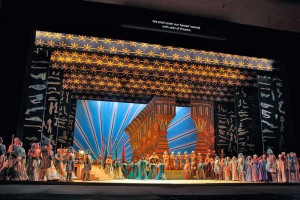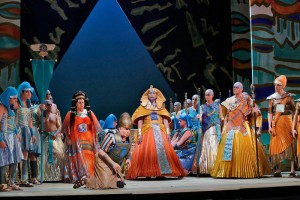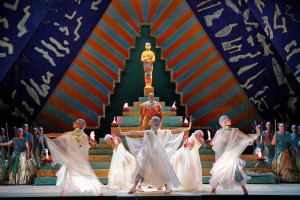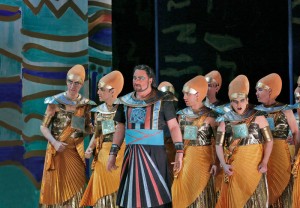EYEING AMNERIS IN AIDA
In this well-loved 150-year-old Guiseppe Verdi classic of Grand Opera, it may be heretical to question the relationship of the principle characters and their so-called “love triangle.” But in the San Diego Opera production it is Amneris, the Pharoah’s love-sick daughter, who seems more the protagonist.
After all, it is Amneris’ world that is thrown off its axis when she discovers that the object of her desire, the warrior Radames, is in love with her slave/servant Aida. It is Amneris who befriends Aida in order to wheedle her confession of love for Radames. It is Amneris who, succumbing to her jealousy, has Radames arrested for 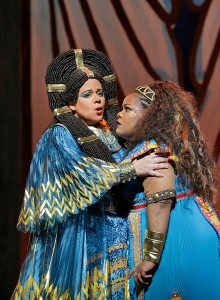 treason. And it is Amneris who, in the end, turns against the priests in a futile attempt to save Radames from death. Amneris flares a transformative arc of unrequited love (“Fill my heart with bliss…”) to painful self-awareness (“Jealousy causes eternal grief.”)
treason. And it is Amneris who, in the end, turns against the priests in a futile attempt to save Radames from death. Amneris flares a transformative arc of unrequited love (“Fill my heart with bliss…”) to painful self-awareness (“Jealousy causes eternal grief.”)
Aida, on the other hand, suffers love endlessly. Her bond with Radames is unshakeable. They never waiver in their love for each other, even when flirting with patriotic verve that threatens to pull them apart. From start to finish she is on a singular and desperate track. Though rarely is there joy in her love dominated by lyrics of dread (“My Gods have always been against me”), despondency (“… I, the slave forgotten”) and doom (“I shall make the dark waters of the Nile my grave”). Radames feeds this woeful despair when, in planning their escape, he sings: “The endless desert will be our bridal chamber.”
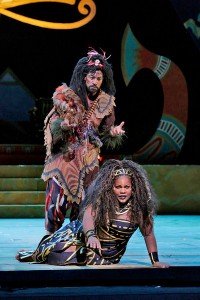 What chance does Amneris have to form a triangle with this gloomy pair, no matter how ill-fated? In the end it is the Pharoah’s daughter who has my empathy and Jill Grove brings soul and substance to the role, exemplified by her second act plea to the priests.
What chance does Amneris have to form a triangle with this gloomy pair, no matter how ill-fated? In the end it is the Pharoah’s daughter who has my empathy and Jill Grove brings soul and substance to the role, exemplified by her second act plea to the priests.
Still, the triangle forms a major image system throughout the opera with Set Designer Zandra Rhode’s sliding angled tormentors creating multiple pyramidal frames. From the opening image of a scorchingly backlit Aida, Lighting Designer Chris Maravich casts her body in a long foreshadowing of the final triangular chamber where she and Radames will love their last. Maravich also turns Rhode’s vibrant aqua and gold costumes molten in the climactic Triumphal March, joyously staged by Andrew Sinclair. It is here that Latonia Moore excels as Aida, her voice rising above the combined crescendo of full chorus and San Diego Symphony orchestra led by Daniele Callegari.
Rhode’s set, seen last year in the Houston Grand Opera production, also employs the Eye of Horus to great effect. At first lost in a sea of hieroglyphs, it expands to engulf the army’s breastplates, and then rises large as a celestial luminescence over the Temple of Isis on a dark Nile night. Finally, it engulfs the entire stage as a wall isolating Amneris in a virtual prison as she pleads with Radames and curses the priests.
As for Amneris: Can we send the libretto back to Antonio Ghislanzoni for some slight tweaking? I’m sure Guiseppe wouldn’t mind. As this production proves, my imagined opera entitled “Amneris” could run for another 150 years.
photos © Ken Howard
Aida
San Diego Opera at the Civic Theatre
scheduled to end on April 28, 2013
for tickets, call (619) 533-7000 or visit http://www.sdopera.com

